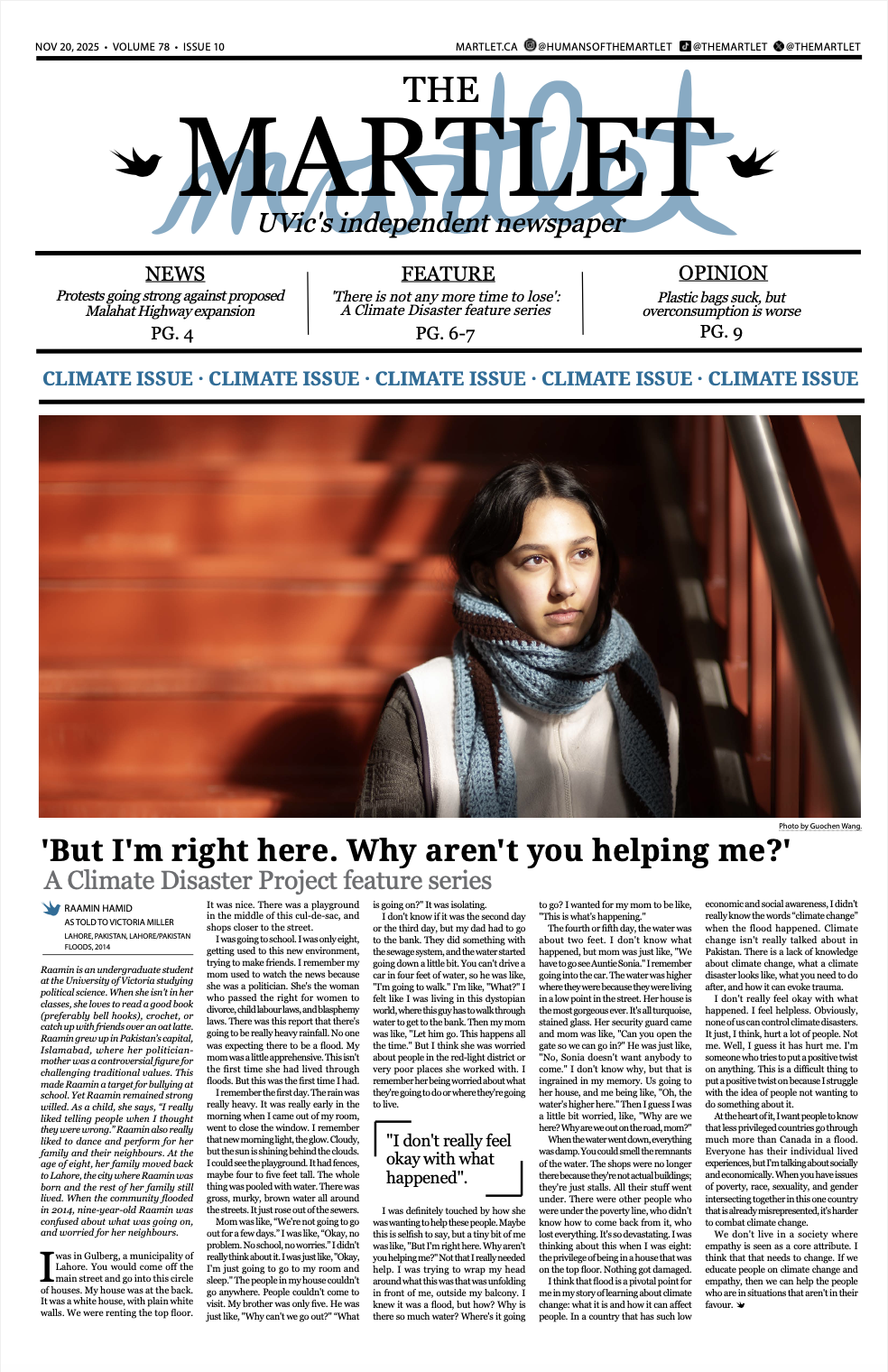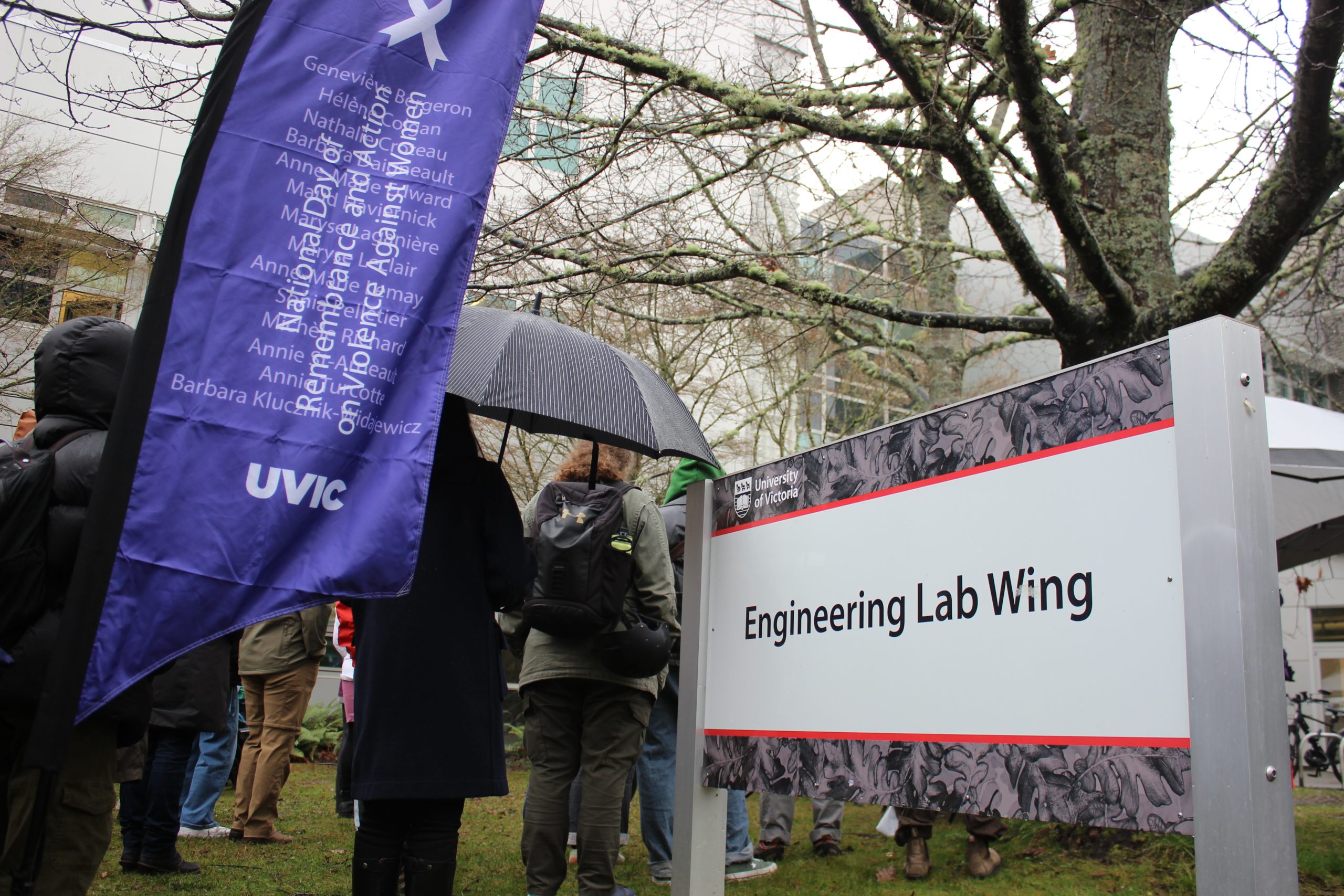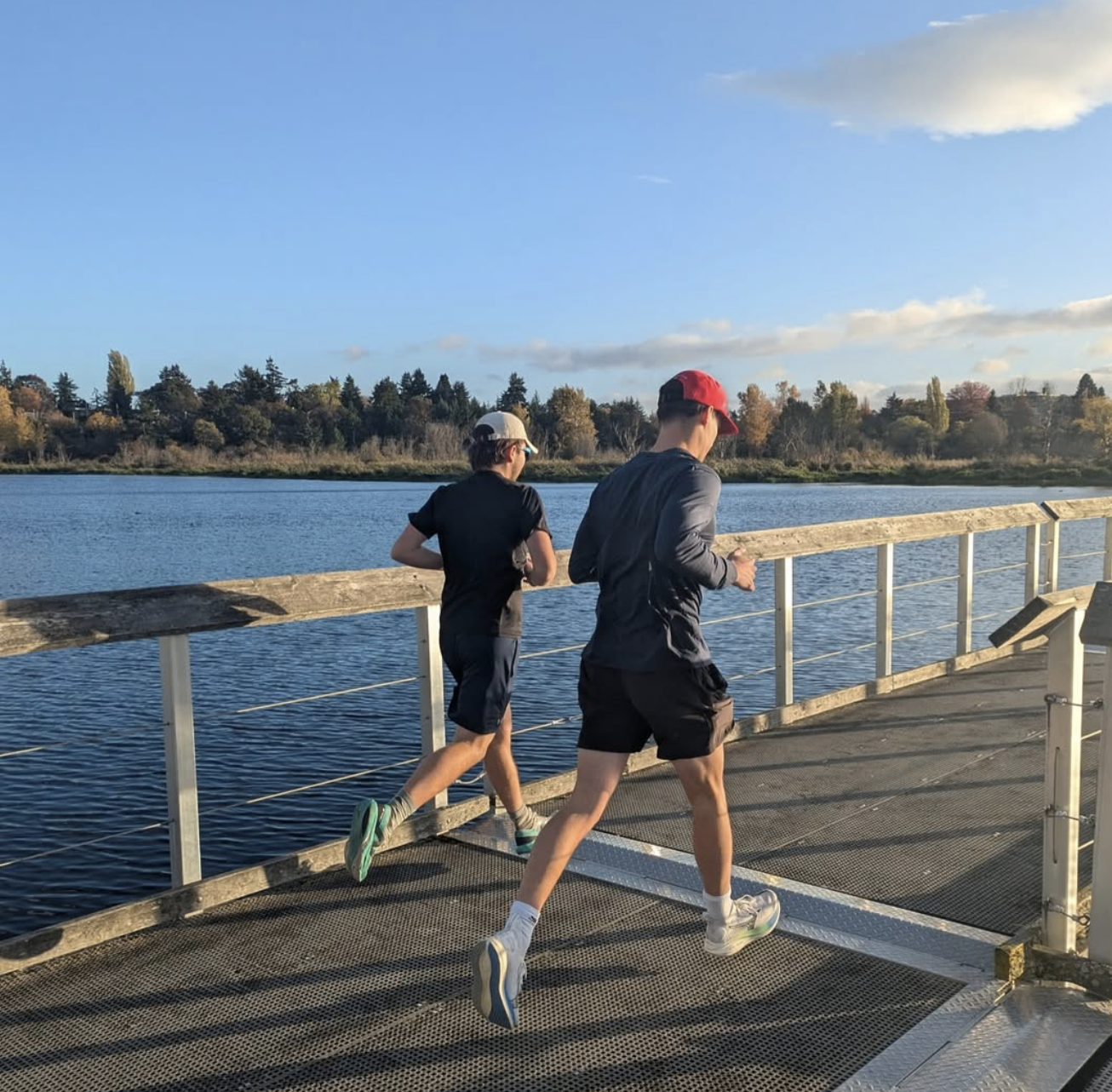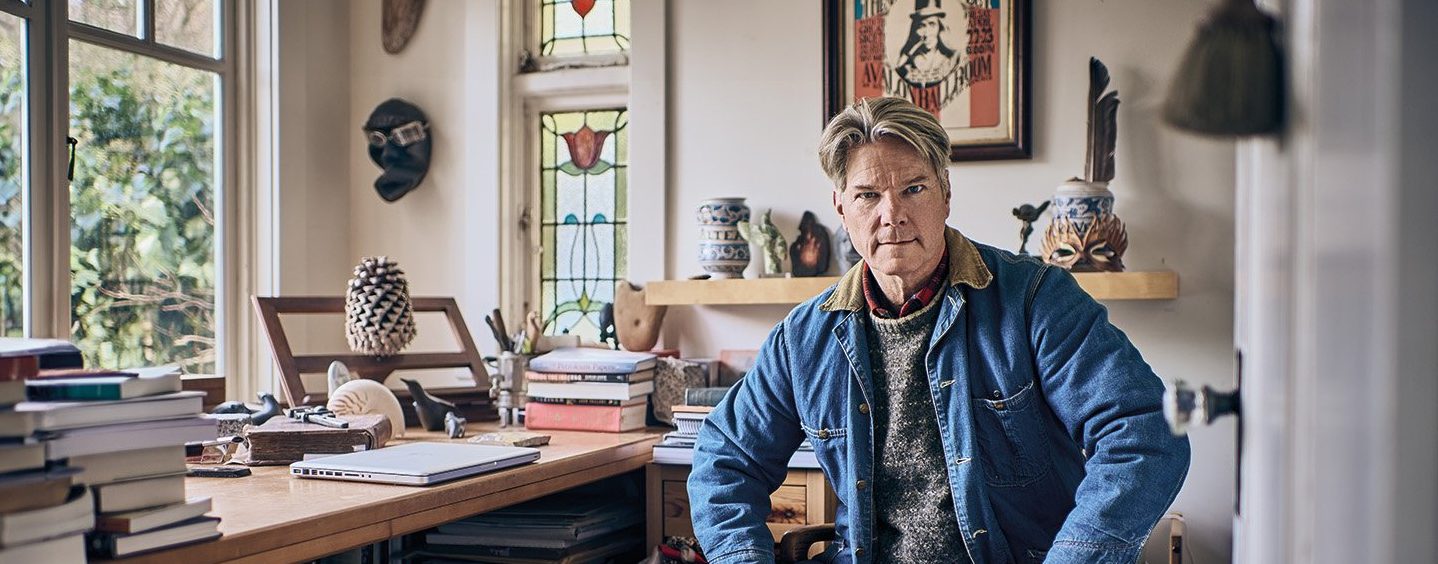UVic Vikes cheerleaders are undefeated in BC since 2017 — but still waiting for varsity lift-off
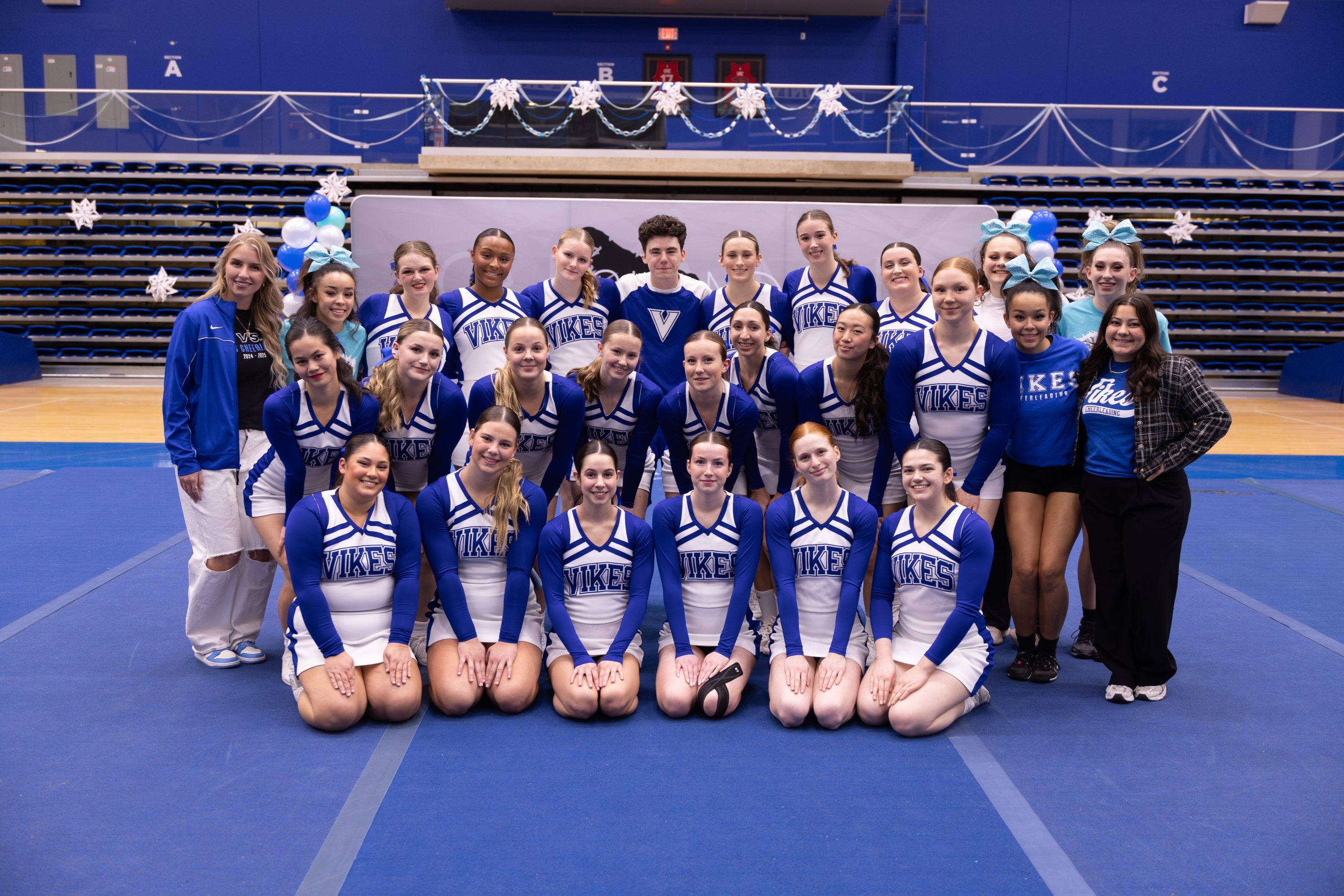
Photo by Armando Tura.
Laughter and cheers shrilled through the air, echoing off the CARSA Performance Gym walls. It was Dec. 1, and the Vikes Cheer Team were holding their first fundraiser showcase event of the school year. A younger generation of cheerleaders — hair adorned with comically oversized sparkling bows — lined the bleachers to watch their idols, the Vikes Cheer Team, take the stage.
The Vikes’ routine was the closing performance of the night, after the toddlers to teens from Island Elite Cheerleading had taken turns performing on the mats in the hours prior.
As the Vikes cheerleaders gathered front and centre, a hush fell over the room. The audience of young cheerleaders watched in awe as their uniform-wearing, prop-turning idols marched to the back right corner of the mats.
Charging onto the floor waving banners and poms, the Vikes began their chant — crisp syllable after syllable reverberating through the gym, huge smiles on their faces. When their musical track started, it was impossible to decide where to look. Flips, turns, and tosses exploded across the mats. During each stunt, another one was taking shape in the background. No second was wasted.
Little girls leaned forward in their chairs, eyes wide. Coaches held their breath. And, when the team struck their final show-stopping human pyramid pose, a deafening wave of applause, whoops, and cheers rolled over the bleachers.
Not one pom had been dropped. The cheerleaders’ smiles were no longer performative, but genuine. They’d rocked the floor, and they were proud.
The UVic Vikes Cheer Team are provincial legends — undefeated in B.C. since 2017. But even with celebrity status and no shortage of accolades, they still operate as a recreational club at UVic, not a varsity team.
The issue is national: Cheerleading still does not belong to U Sports — the governing body of Canadian university sports in Canada — so the Vikes have remained a club at UVic since the team’s inception, despite being fierce competitors and committed student-athletes.
Vikes cheer has good reason to want to prove that competitive cheerleading is more than waving pom-poms from the sidelines of a football game — it combines agility, flexibility, strength, and fearlessness.
This year, with a roster full of rookies, significant changes to their routine, and a national competition on the horizon, the team is gearing up to reach new heights.
“You can’t wish your way to success”

Photo by Ashley Ciambrelli.
Every practice begins with the team setting up a series of nine state-of-the-art cheerleading mats on the Performance Gym floor at the Centre for Athletics, Recreation and Special Abilities (CARSA) at UVic. As they warm up, a portable speaker system sits royally at the front of the mats, pumping out high-energy tunes like “365” by Charli XCX and “HOT TO GO!” by Chappell Roan, while one of the four team captains chooses the songs for their breaks.
The Vikes Cheer Team practices for over seven and a half hours each week. Captain Camryn Sartori says the practice regimen is hard, but everyone is “putting their time in.”
The beginning of practice involves a stretching warm-up, across-the-floor drills, and marking sections of the routine in groups. By the halfway point of a typical practice, the team is almost ready for a full-out run-through of their routine. As the team gets water, Jia Curtis, an energetic back spot for the team, snatches a cordless microphone from the coach’s portable speaker box.
Her black bun bounces as she flies across the mats, while the Pitch Perfect song “Riff Off” blares from the speakers. Mishan Sheere and the team’s other head coach, Kate Bell, laugh, saying, “Jia obviously not shy-a,” before turning back to their notes.
By the end of the first run-through of their number, most of the team is springing around the mats. They’re ready to give the next run their all.
Teammates lunge for their pom-poms, signs, and megaphones which lay on the floor like confetti before joining the charge at the back of the mats, waiting in buzzing silence to begin.
Bell’s motto when it comes to drilling the routine is, “you can’t wish your way to success.”
A collegiate competitive cheer routine contains an ensemble of stunting, tumbling, pyramid, and chant, and runs at about two and a half minutes. The team shouts out their counts throughout to keep their timing, chanting aggressively: “1—3—5—7, 1—3—5—7, 1—3—5—7.”
This chorus bounces across the plastic bleachers of the CARSA Performance Gym until the team hits their final pose — breathing heavily and smiling hard. At the end of each practice, the team stands in a circle, making a “V” with their fingers. “Vikes!” they exclaim, clapping four times symbolizing the team’s fourteen years of operation, before grunting and doing a rowing motion in honour of being a Vikes athlete.
Practices weren’t always so functional or well-organized. Back in 2010, the team’s founding year, they practiced in the McKinnon Gym on three uneven mats that barely stuck together. Thanks to self-funding, fundraising events, and the strong community of alumni, the equipment and the team’s reputation has grown exponentially.
This strong network is partly thanks to the coaches, who’ve helped keep the sport alive at UVic despite the team flying under the radar for many years.
The head coaches of the team, Bell and Sheere, are also UVic alumni, and even tried out for the team together in the club’s first year. Now, fourteen years later, their love and dedication to the team remain. Bell says that her friendship with Sheere and her commitment to coaching the Vikes are “the one thing in [her] life that’s been consistent for the past 14 years.”
Bell and Sheere are both volunteer coaches while also holding full-time jobs. While this presents obvious challenges, they’re committed to the team because it’s a passion, and a community they love to be part of.
Bell, recently married, had her honeymoon in November. She says she feels “so guilty though. I [had] to miss three practices.”
“We’re so lucky that they do it,” says Captain Anika Mistry, a lively base for the team, emphasizing how important strong role models as coaches are in women-dominated sports. “They’re such great people to look up to. Strong, confident women.”
Coach Sheere also runs the first competitive cheerleading gym in Victoria — Island Elite Cheerleading — which she opened with Bell in 2015.
When the team first began, their uniforms were simple blue long-sleeve shirts with black gym shorts. A few years ago, Bell redesigned the uniforms to give the team a professional edge with a coordinated skirt and long-sleeve top in white and royal blue colours with matching coloured bows. Now, at competitions, the athletes feel the prestige — and the pressure — that comes from being a Vikes athlete.
“We always joke we feel famous sometimes, because little kids or random people will come up to you … just because you’re a Vikes cheerleader,” says Sartori.
Sartori, who grew up on the mainland, says that as a high schooler she’d always dreamt of being a Vikes cheerleader.
“I didn’t choose UVic solely for cheer, but I’m so glad I did,” she says.
Mistry, who’s been on the team for three years, has a similar story.
“I was like, ‘If I go to UVic, I definitely want to cheer there,’” she said.
“I feel like an old woman already”
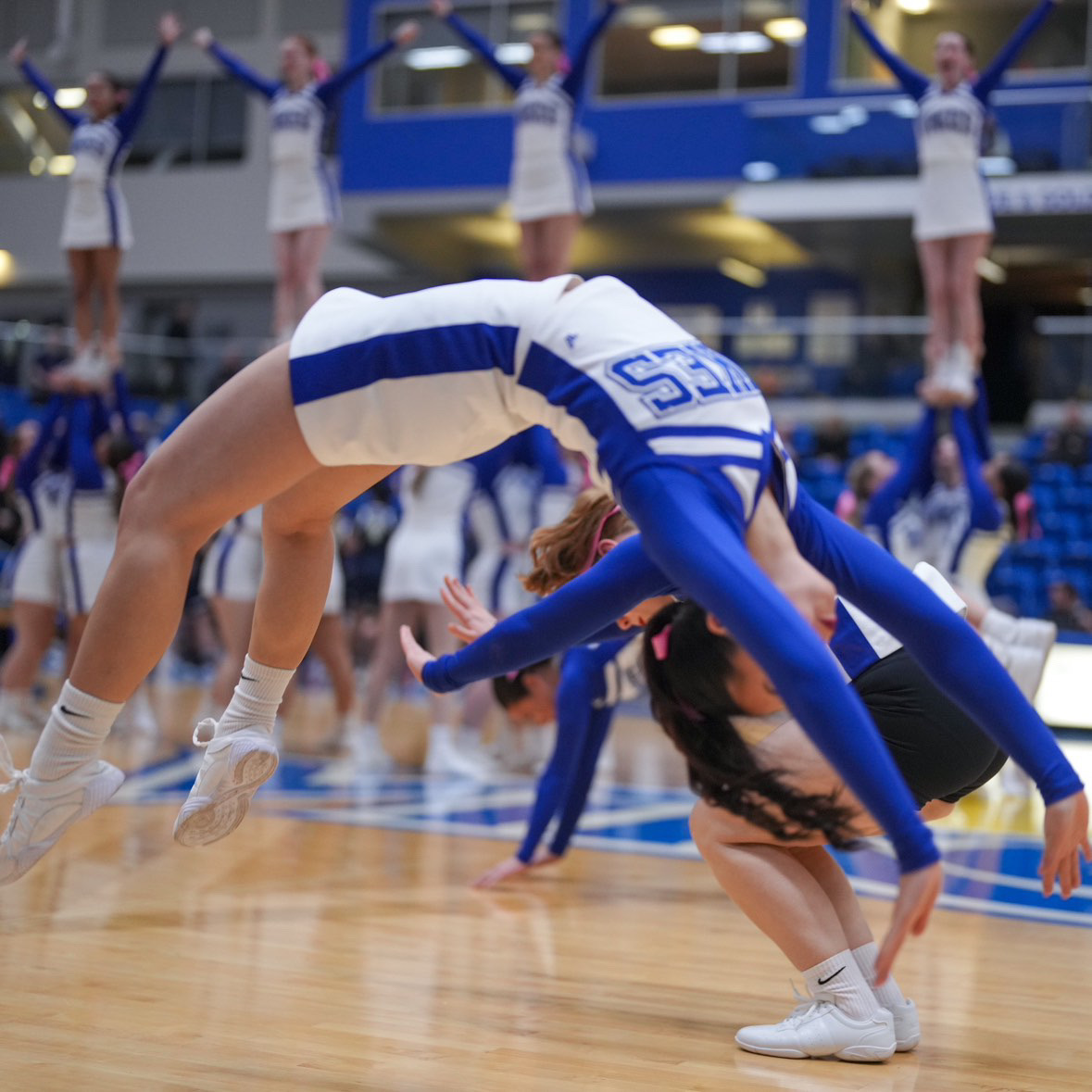
Photo courtesy of Kate Bell.
Cheer is, surprisingly, one of the more dangerous contact sports when it comes to serious injuries. The combined skills and trust required to execute stunts leave little room for error. And it’s not just the physical risks — cheer demands a mental toughness that matches its high-stakes environment.
As Captain Beth Maddison says, “We stack people on top of people.” In an environment like this, group coordination and serious athleticism are both necessary to be a competitive cheerleader.
Mistry says, “I feel like people don’t understand the difficulty of the things we do. It really does require a lot of athleticism.”
Although Bell and Sheere both have the highest accreditation a cheer coach can have in B.C., injuries are inevitable when such dangerous stunts are being performed.
“It’s not like you reach a maximum point and then you can’t go anymore. I’m always learning new stuff,” Maddison says.
Despite the lack of awareness for competitive cheerleading, the sport has actually been around since the mid 1980s in Canada, starting in Nova Scotia. Later, in 2004, both the International Cheer Union and Cheer Canada were founded. However, it’s really been within the past few decades — since the mid 2000s — that competitive collegiate cheer has exploded in both popularity and volume. Due to this relative newness, the sport is still being molded, so skills and safety rules are ever-changing, keeping coaches and athletes on their toes.
“There’s a lot of moving parts in a cheer routine,” Bell says. “One person out of place could result in someone falling, or a stunt failing.”
During practice, these fearless flyers don’t dwell if they’ve fallen previously when performing a stunt. Instead, they throw their bodies full force into the flips and twists until they achieve a clean landing. But the pressure isn’t just to avoid falling — it’s also to satisfy the crowd.
Sartori, a seasoned “flyer” who is often lifted or thrown into the air, says, “you put a lot of pressure on yourself for the stunt to hit because you’re the one up there. You’re the one that’s seen by the crowd.”
Due to the high risk involved in cheerleading, Bell says safety is incredibly important. “We do ‘flipping baskets’ where people could end up [seriously injured]. It’s a very very real reality.”
Currently, if a serious injury occurs during practice at CARSA, the coaches use their first aid and, if necessary, call campus security for assistance, as their club status means they don’t have access to the sports clinic just down the hall.
Unfortunately, as a recreational sports club, any injuries (big or small) at practice or at competitions mean the team is encouraged to go to the hospital, physiotherapy clinics, or the general walk-in clinic on campus.
When Maddison received a hit to the head, she went to the CARSA sports clinic where she says she was denied concussion testing. The team cannot receive rehabilitation services either, creating barriers to reliable medical care.
Recognition as a varsity team would grant the team access to critical resources like the sports clinic services, which would help to ensure the athletes’ safety and well-being.
Beyond acute injuries, athletes feel the toll cheer takes on their bodies day-to-day.
“I feel like an old woman already,” says Mistry. “The whole time I’m sitting in class, I’m having a hard time focusing because my back hurts.” A reliable and accessible medical staff for cheerleaders would be a game-changer.
However, cheer isn’t all work — it is also a way for team members to relieve stress and practice a sport they love. When school becomes overwhelming for Sartori, she says, “I have [cheer]. I can put all my positive energy into this.”
Despite this, cheerleading at the collegiate level takes its toll, too. Bell remembers her days cheering at UVic as being “so busy that you can’t even think straight.”
Now, over a decade later, not much has changed — the athletes, like many of their peers who play other sports while balancing a full course load at UVic, still struggle with time management between sport commitments, school, and the other intangibles of university life.
In cheer, funds are critical — going towards upgrading uniforms, paying competition fees, covering travel costs, buying new equipment, and more. Part of the cheer team’s semesterly duties go towards fundraising events, which are necessary to keep the team afloat. Planning and hosting these events means additional hours, which the team could’ve otherwise used to practice or rest.
Being a certified recreational sport club as opposed to varsity-standard obviously affects the club’s financial operations, but it also comes with some perks. The team doesn’t have to pay rent for practice spaces, which would otherwise cost them thousands of dollars, and they receive around $1 000 annually to help cover expenses.
Little funding also means athletes often pay out-of-pocket for travel expenses, competition fees and uniform cleanings.
“We’re capable of so much more”
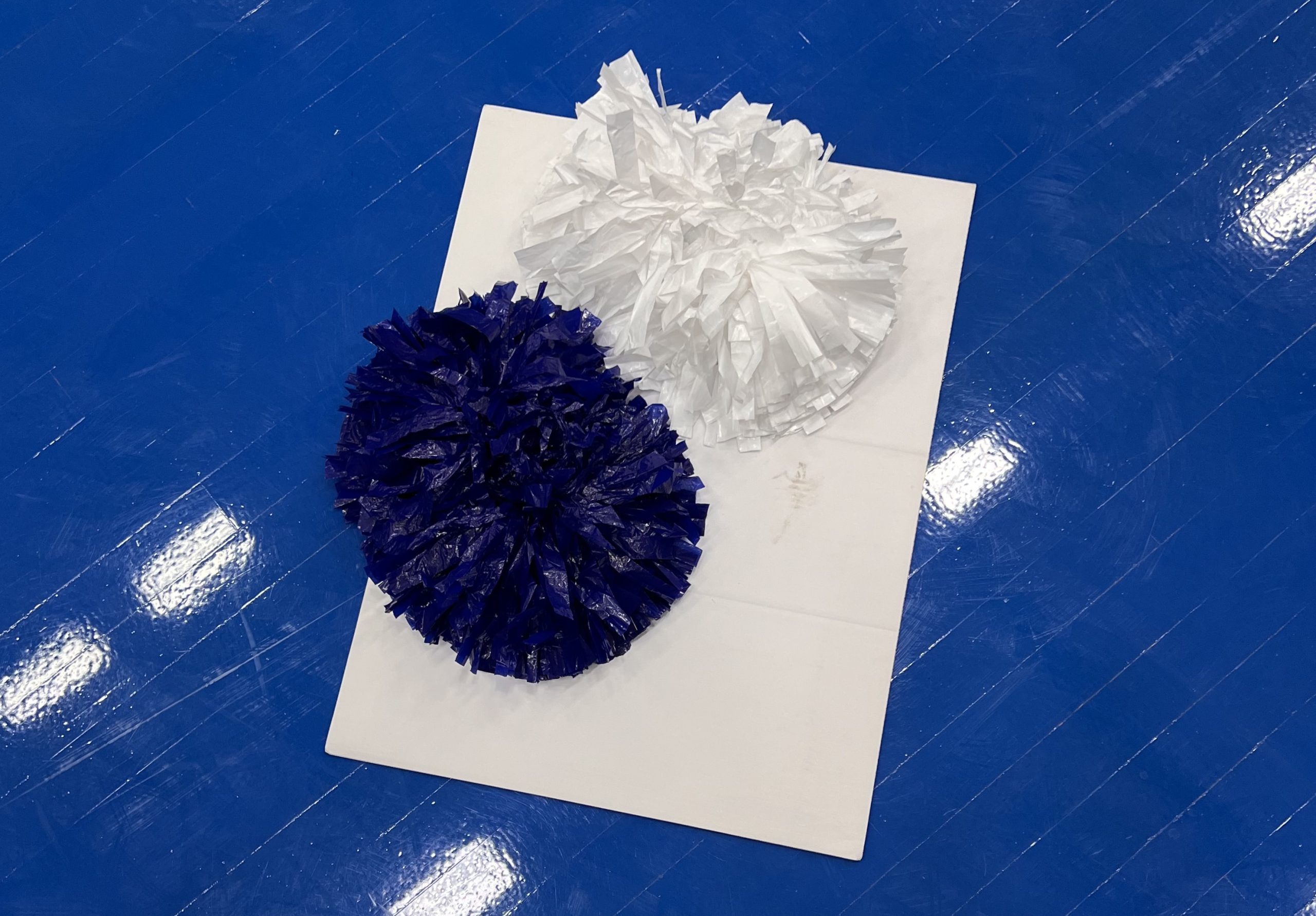
Photo by Ashley Ciambrelli.
Outside of performing on the sidelines of varsity sports games, the team currently lacks an outlet to show their skills in the broader UVic community. With their styled hair, makeup and pretty costumes, it’s hard for the cheerleaders to be taken seriously as athletes, rather than being seen as a supporting act.
According to Mistry, what UVic sees of the Cheer Team is their safe, game-day material, not their competitive routine.
“We’re capable of so much more, but we don’t have an opportunity to show that off to everyone,” she says.
Not only is the team the reigning provincial champ for seven years running, in the past ten years the Vikes cheerleaders have taken home three provincial titles, and won fourteen first place awards. The team is hungry for varsity status, but the path to getting there is long and winding.
Nicole Greengoe, Executive Director of Wellness, Recreation and Athletics at UVic said in an emailed statement that “introducing a new varsity program is not a black-and-white matter.”
And grey it is. Sheere told the Martlet that this issue is “way beyond just one university.”
According to Sheere, in order to be classified as a varsity sport, cheer would have to belong to U Sports. And, in order to be considered, a number of hoops must be jumped through, including the following: every province must recognize cheer as a sport from a provincial level, and cheer needs an official National Sport Organization (NSO) — with a national championship.
“It’ll be anyone’s game”
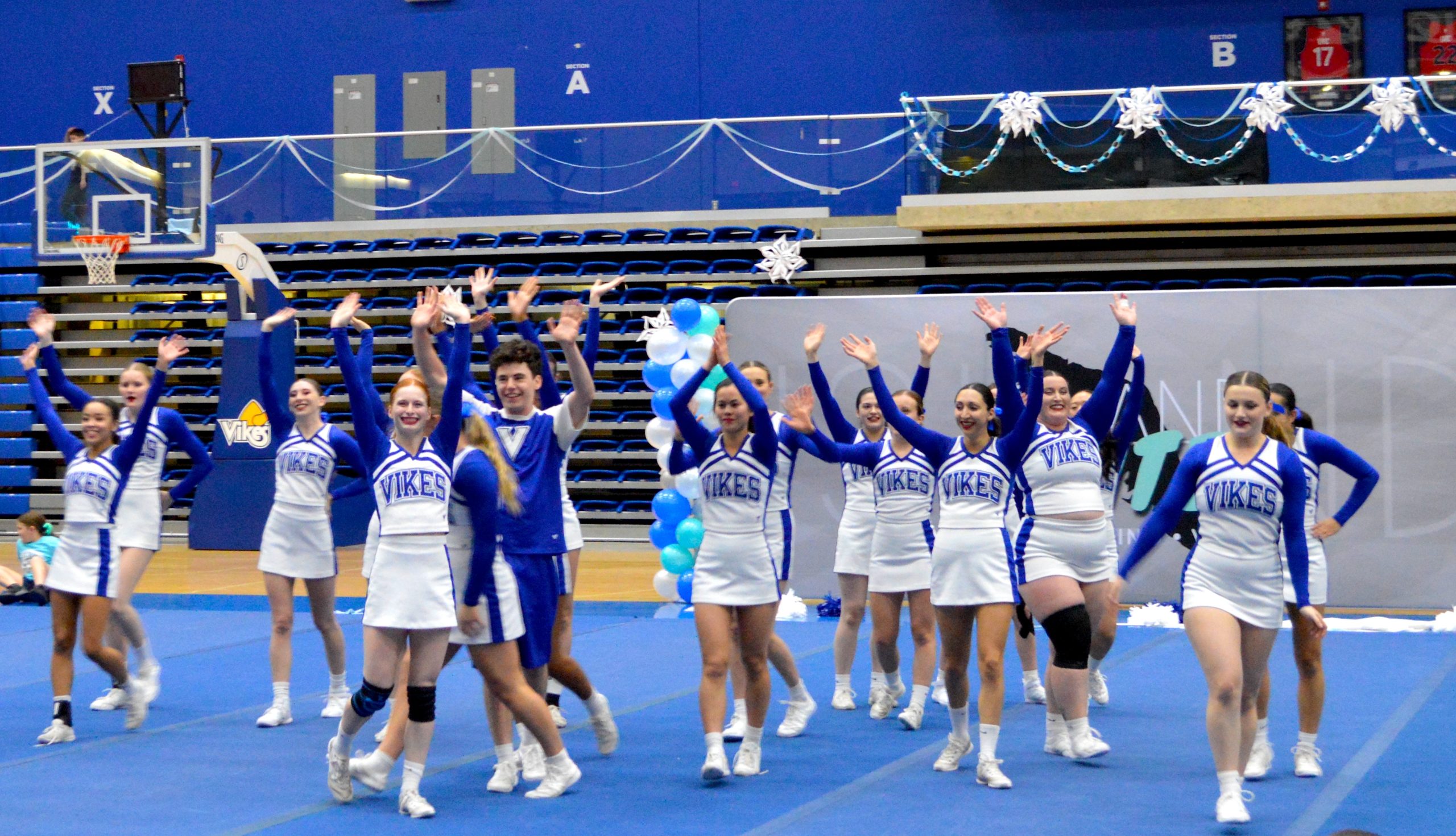
Photo by Ashley Ciambrelli.
The official cheer competition season starts in January, with one competition in B.C., before the big leagues in Brampton, Ontario take place in February.
Recently, the Vikes team welcomed a new male athlete for the first time in over four years. Brian Bargholz, a self-taught tumbler with no official cheer experience, shows up to practice with a smile and a pledge to learn and be a part of the community.
Adding Bargholz to this all-girl team signifies more than a higher testosterone count. Having a male cheerleader means that Vikes Cheer now qualifies as a small co-ed team. This will only slightly impact their routine, but will also change the division they compete in at nationals.
This season, the pressure will be on, as 18 out of 26 members are rookies. With so many new feet on the mat, it’s up in the air whether these rookies will fall or fly under the pressure.
In just under a month, the Vikes Cheer Team will attend the Power Cheerleading Athletics (PCA) Cheer Canada Collegiate Nationals competition for the first time. The competition, which was previously organized by an independent event producer, is being run for the second time this year under Cheer Canada — newly minted as a National Sport Organization — which Sheere says makes it a “true collegiate nationals,” and brings cheer one step closer to recognition from U Sports Canada.
The PCA marks a stark growth for Canadian cheer. Not only does it finally allow Canadian collegiate teams to compete coast-to-coast, exclusively with each other, but the rules have changed slightly, too. This year, the tumbling routine is weighed more than the Vikes are used to, with the chant portion making up only 35 per cent of their score. This puts the odds against them, as the chant was always one of their top skills. Now, the competition requires only one chant performance, compared to two of the tumbling routine.
“We don’t know exactly how it’s gonna pan out. It’ll be anyone’s game,” says Bell.
Vikes Cheer will compete in the Premier division — the highest level. Mistry is optimistic, saying, “I still think we can hold our own,” despite never having competed against some of the East Coast teams before — and never in the co-ed division. All four captains are excited and nervous to see how this competition will round out.
No matter how difficult practices are or how tired an athlete is feeling, they know that, once they’re on the mats, they have the support of the people around them to lift them up physically and mentally — and catch them when they fall.
Maddison says, “even though you might not be close with everybody, you know they’re going to be there for you.” Bell encourages the athletes to cherish this time because they can only compete at a collegiate level for four or five years of their lives.
“I would love to go on the floor now, but I’m too old,” she adds.
After graduation, most current Vikes cheerleaders will also inevitably retire. Some will coach cheerleading or join Victoria’s all-star Worlds team at Island Elite, which is open for all ages. Some will maintain their legacy by giving donations that the team desperately needs.
But for now, the Vikes Cheer Team has a competition to win. By channeling their provincial winning streak into their work at nationals, the team hopes to prove their worth as competitive athletes — and make strides toward one day, hopefully, gaining varsity recognition from U Sports Canada.




